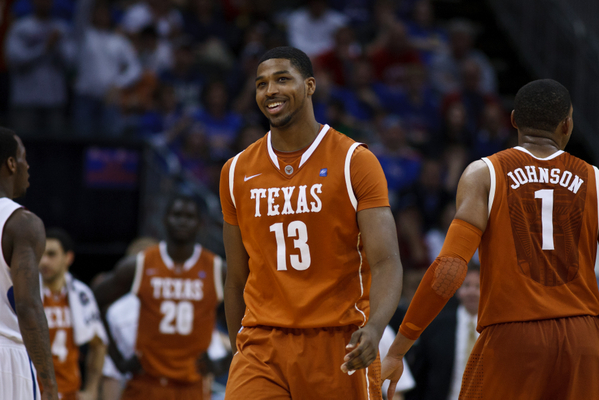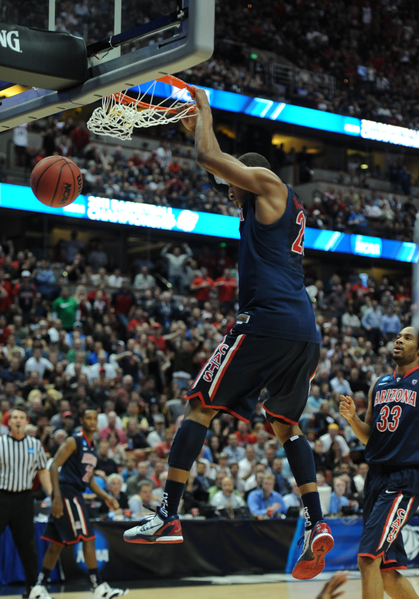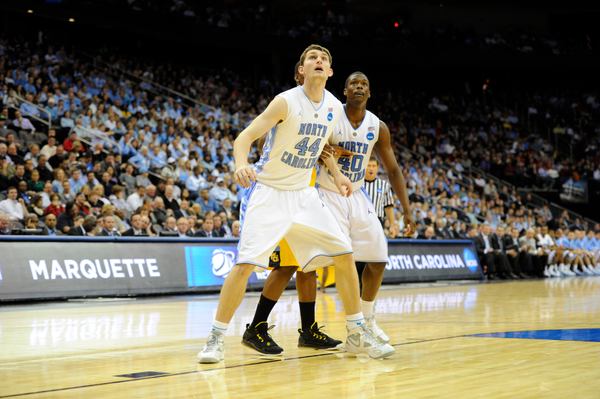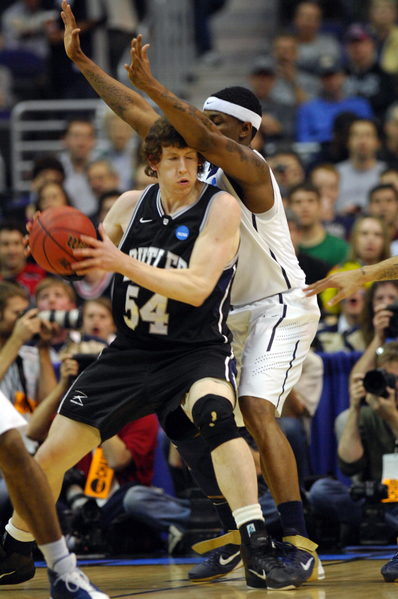Season in Review: By the (Jersey) Numbers
Posted by rtmsf on April 7th, 2011Andrew Murawa is an RTC contributor. When he’s not traveling all night to get to Vegas, Los Angeles, Tucson or Anaheim to cover games in the southwestern quadrant of the country, he’s acting as the RTC correspondent for the Mountain West and Pac-10 Conferences and writing about whatever strikes his basketball fancy.
When it comes to wrapping up a college basketball season, I have a hard time doing an All-American team, because, for one, it just seems hard to narrow down four and a half months of basketball to just five names (or even ten or 15 if I add a second or third team – although, I’ll probably do that too). Instead, in the interests of recognizing more of the players that filled up my brain this season, what I’ll do here today is take all 37 possible uniform numbers (only digits zero through five are possible uniform numbers in NCAA basketball, to aid referees in calling fouls and the foulers) and pick one player for each jersey number. Note that I am not always going to pick just the best player here. My own prejudices and likes/dislikes will factor in, plus I want to be able to pick a guy that I will most remember from this season. And, in the case of a tie, a senior will get the nod. So without further ado, here is my list of Players of the Year by uniform number.
0 – Jacob Pullen, Sr, Kansas State – As I said before, tie goes to the senior, and in this case, the freshman Jared Sullinger gets beat out by a guy who left his heart on the court in his final game as a Wildcat, scoring 38 amazing points in a loss to Wisconsin in the Third Round of the NCAA Tournament. Pullen goes down in history as the all-time leading scorer in Kansas State history, and his exploits in March will be talked about there for years to come.
00 – Rick Jackson, Sr, Syracuse – As far as the scorekeeper is concerned, there is no difference between 0 and 00, but I see two big zeroes on Jackson’s back, and opponents saw a double-double machine for the majority of the season. He posted 17 double-dips on the season and, despite fading a bit down the stretch, was one of the most improved seniors in the country this year.
1 – Kyrie Irving, Fr, Duke – Irving’s college career is complete as he declared for the NBA Draft on Wednesday. You won’t find his name on any all-timer lists in Durham, as he played just 11 games in his time as a Blue Devil due to a toe injury. When he was on the court, however, he was among the handful of the best players in the nation, with quickness, awareness and maturity rarely seen among freshmen.
2 – Nolan Smith, Sr, Duke – His college career ended with one of the worst games of his career, but for huge swaths of this season, Smith was in the conversation for National Player of the Year. He took over the point guard role when Irving went down with his injury and did a fantastic job of balancing his team’s need for a creator with its need for Smith to score.
3 – Jeremy Lamb, Fr, Connecticut – Jim Calhoun’s precocious freshman earned this honor almost entirely in March. Sure, he had a streak of eight-straight double-digit scoring games in January and early February, but in March, Lamb took his game to a new level and became a consistent second option to Kemba Walker. From the start of the Big East Tournament straight through to the National Championship game, Lamb never failed to score in double figures and averaged 15.3 points per game over that stretch.
4 – Jackson Emery, Sr, BYU – Aaron Craft almost got the nod here, but once again we’ll give the upperclassman the benefit of the doubt. And make no mistake, Emery is very deserving on his own merits, regardless of class, averaging 12.5 points and 2.7 steals per game as Jimmer Fredette’s sidekick in the Cougars’ playmaking backcourt. Emery goes down in history as the career steals leader at BYU.
5 – Kendall Marshall, Fr, North Carolina – I’m not sure Marshall is the best player in the country wearing a single five on his back, but he was likely the most important one – and the biggest story at that. He took over the starting point guard position in Chapel Hill in mid-January and led the Tar Heels to a 17-3 record from there, averaging 7.7 often spectacular assists per game and kick-starting much-heralded freshman wing Harrison Barnes along the way.
10 – Alec Burks, Soph, Colorado – While the Buffs missed out on their goal of making the NCAA Tournament, Burks did everything he possibly could to keep them in the conversation. Just twice all season did he fail to score in double figures (both CU wins, ironically), leading the team with 20.5 points per game. But more than just a scorer, Burks also led the team in assists (and notched six games with more than ten set-ups) and finished second in rebounds with 6.5 per night.
11 – Jordan Taylor, Jr, Wisconsin – The Badgers’ point guard was on the very short list of the nation’s most efficient offensive players. He almost never turned the ball over, knocked down 43% of his threes and 83% of his free throws and handed out almost five assists per night. Unfortunately, his season ended in a horrific slump (22-78 field goals in his last five games), but he’ll be back next season to wrap up his college career on a better note.
12 – Dwight Hardy, Sr, St. John’s – This was a loaded number, with guys like Brandon Knight, Talor Battle, Kyle Singler and Ashton Gibbs left on the cutting room floor, so you know Hardy had to be very deserving. He averaged 18.3 points per game in leading the Red Storm back into the NCAA Tournament, living at the line in key wins at Marquette and Villanova and at home against Pitt, and took down the Big East’s Most Improved Player award, in addition to First Team honors.
13 – Tristan Thompson, Fr, Texas – The Big 12’s Freshman of the Year was a load from day one in Austin. Despite struggling with his free throws all season long, he averaged over 13 points and almost eight rebounds a game for the Longhorns, and really turned it on in conference play. However, he was largely absent in Texas’ season-ending loss to Arizona, meaning his return for his sophomore campaign will give him a chance at redemption.
14 – Arsalan Kazemi, So, Rice – He’s not much of a national name, but he was one of the nation’s best rebounders, a fixture at the free throw line and a highly efficient offensive player on a middling Owl squad. Averaging 11 rebounds a game in addition to his 15.2 points per night, the 6’7 Iranian whirlwind won the United State’s Basketball Writer’s Association’s Most Courageous Award.
15 – Kemba Walker, Jr, Connecticut – It is awful hard to leave Kawhi Leonard on the outside looking in, but Walker is the obvious choice here. Not only did he carry his team to a national title, but he was one of the most exciting and enjoyable players to watch along the way. You’ll remember him just destroying Gary McGhee on a ridiculous move long after Walker has moved on from Storrs. But there was also this, and this, and countless other amazing plays.
20 – Bradford Burgess, Jr, Virginia Commonwealth – The sharpshooting wing out of Midlothian, Virginia, was a major reason the Rams were able to “Shaka the World” in advancing from the First Four to the Final Four, knocking down 17 of his 29 three-point attempts in the NCAA Tournament and averaging 15.7 points per game in VCU’s magical run.
21 – Jamie Skeen, Sr, Virginia Commonwealth – While Burgess was VCU’s most efficient offensive player, Skeen wasn’t far behind. After leaving Wake Forest after an academic suspension, he wound up in Richmond and thrived, leading the team in points, rebounds, blocks and field goal percentage, while still knocking down 36 threes at a 42% clip. While there were plenty of great stories on the VCU squad, Skeen was the guy that made that team go.
22 – Charles Jenkins, Sr, Hofstra – With major apologies to Marcus Morris, a second-team All-American, I’m giving the edge to the great mid-major senior here (and yes, I realize, I’ve got three CAA players in a row – not something I would have guessed when I started putting this together). Jenkins was the most efficient high-use offensive player in the nation, according to Ken Pomeroy, ahead of guys like Derrick Williams, Jon Leuer, Kemba Walker and Jimmer Fredette, just to name a few. Without a ton of help, he averaged 22.6 points per game, led the Pride in assists and steals, knocked down 66 threes, and still managed to shoot 52% from the field, an amazing number for a guard.
23 – Derrick Williams, Soph, Arizona – While Jenkins was the most efficient offensive player in America, Williams was a close second. The difference is, Williams got his team to the Elite Eight, while Hofstra bombed out in the first round of the CBI. And Williams put up his numbers from the forward position, knocking down an amazing 42 of his 74 three-point attempts (just a few makes short of an all-time record from deep), even more impressive considering Williams came into the season with an unproven perimeter shot (he made just four threes as a freshman). Throw in a penchant for getting to the line with regularity, excellent rebounding and the ability to throw down highlight reel dunks (exhibit A, exhibit B, and exhibit C – I rest my case) and the “Whole Enchilada from La Mirada” was on the very short list of the best players in 2010-11.
24 – Blake Hoffarber, Sr, Minnesota – This season did not turn out for the Golden Gophers the way Hoffarber or Tubby Smith wanted it to. But Hoffarber was the consummate senior leader for a team damaged by defection and injury. When senior point guard Al Nolen went down to injury after backup point Devoe Joseph decided to transfer, Hoffarber shifted away from his typical role as a spot-up shooter from Minnesota, and took over the reins at the point. Now, sure, the Gophers went 3-10 during that span, and Hoffarber struggled to find open shots without others finding him, but the Minnesota legend wrapped up his college career in unsurprising fashion: doing whatever his coach and his team needed from him.
25 – JaJuan Johnson, Sr, Purdue – The last two seasons in West Lafayette for Johnson will forever be a matter of what-could-have-been. If Robbie Hummel doesn’t get hurt last season or in the preseason this year, the Boilermakers may have been national championship contenders. But Johnson never worried about the what-ifs, he just played. And played extremely well, averaging 20.5 points, 8.6 rebounds and 2.3 blocks – all team highs, while shooting 49.4% from the field and 81% from the line. Those are amazing percentages to be found in a guy who is also one of the best defensive big men in the country.
30 – Jon Leuer, Sr, Wisconsin – Like Williams and Walker and Jenkins, Leuer was in the upper echelon of high-use, high-efficiency players this year. Another big guy shooting obscene percentages from the line and from deep (84% and 37%, respectively), Leuer was the prototypical big guy in Bo Ryan’s swing offense. He was capable of stepping behind the line and knocking down shots, posting up and scoring over smaller defenders, all while excelling on the defensive glass as well. While there may not be much of an NBA future for Leuer, and while Ryan will likely fill his spot with another similar player off the assembly line in the upper Midwest, Leuer finished his career as a great Badger.
31 – Chris Singleton, Jr, Florida State – Singleton missed six games down the stretch for the Seminoles with a broken foot. And given that the 6’9, 225-pound defensive dynamo, who had shored up some of the glaring weaknesses in his offensive game, has a very profitable NBA future ahead of him, no one could have blamed it if he shut it down for the season. But after his team went 3-3 in his absence, Singleton was more than willing to rev it back up when FSU appeared in the NCAA Tournament. He may not have been his typical dominating defensive presence, the kind of guy that could rack up ten steals or four blocks in a game, but the mere fact that he went back out there proved a lot.
32 – Jimmer Fredette, Sr, BYU – The guy may or may not have been the best player in the nation this season, but he was without a doubt the face of college basketball for a stretch from about December 11, when he scored 33 against Arizona, until the point where BYU was eliminated from the Tournament against Florida, when he had 32 points in a “bad” game. The highlight of it all, though, was 52 points against New Mexico in the MWC semifinals, a game where he only shot a single free throw.
33 – Jon Diebler, Sr, Ohio State – Okay, we’ve talked about guys like Charles Jenkins and Derrick Williams and their insane efficiency numbers. Those guys posted offensive efficiency ratings in the 123-124 range. Diebler posted a 140.6. That is insane. Sure, he wasn’t a high-usage guy, and he definitely benefited from the presence of Sullinger in the middle, but knocking down 114 three-pointers while still shooting over 50% from deep is some pretty heady territory. And given how far the kid from Upper Sandusky has come since he struggled as a freshman, watching him excel as a senior was fun regardless of who you root for.
34 – Keith Benson, Sr, Oakland – 17.9 points, 10.1 rebounds, 3.6 blocks. 371 career blocks. Benson was a dominating figure in the Summit League the past four seasons. But in the Grizzlies season-ending loss to Texas, he proved that he was able to hang with the big boys as well, scoring 15, grabbing 11 boards and blocking three shots. He’ll be playing for a paycheck next year.
35 – Kenneth Faried, Sr, Morehead State – While Benson is a more polished offensive player and a more prolific shotblocker, Faried may be the best rebounder in the nation. He grabbed a higher percentage of rebounds than anybody else in the country for a total of 14.5 rebounds per game. Oh, and he also shot 62% from the field on the way to 17.3 points per game. And only six times all season did he fail to register a double-double. Dominant.
40 – Harrison Barnes, Fr, North Carolina – Barnes came into the season with a load of expectations upon him. He was named a first-team All-American without ever having played a ballgame, and when he struggled to be an impact player right out of the gate, he received a lot of negative attention. However, down the stretch we got a glimpse of his true talent, as he scored 19.9 points per game following the Tar Heels’ loss at Duke, including a 40-point, 12-of-17 performance in a win over Clemson.
41 – Steven Gray, Sr, Gonzaga – For whatever reason, the 40s and 50s are not particularly popular uniform numbers, so around this point we have to start to reach for players. Not that Gray is a huge reach, as he wrapped up a solid career with the Zags by averaging 14 points and knocking down 37% of his threes. But after his 35-point performance against San Diego State in the early part of the season, Gray never again exploded, and wound up hitting just 41% of his shots from the field.
42 – Noah Dahlman, Sr, Wofford – Back to the efficiency numbers, as Dahlman was phenomenal this season, posting an offensive rating of over 130, while using 27.2% of his team’s offensive possessions, a number just 0.8% shy of qualifying him at the top of Pomeroy’s high-use, high-efficiency leaders. Dahlman averaged 20.1 points and 5.6 rebounds, and owned the offensive paint for the Terriers.
43 – Luke Sikma, Sr, Portland – I love Luke Sikma. This is a great kid who averaged 13/10 for a pretty good Pilot team while providing tons of senior leadership to a relatively young group. It’s sort of a shame that this Portland squad could never get over the top and get national exposure for him and guys like Jared Stohl (or T.J. Campbell and Nik Raivio last year).
44 – Tyler Zeller, Jr, North Carolina – This was actually a tough number to pick from. There was William Buford and Butler’s much-improved Andrew Smith, Vandy’s Jeffery Taylor and Arizona’s Solomon Hill. But in the end, we’ve got to go with the Tar Heels’ leading scorer, most efficient offensive player and, judging by his performance in the NCAA Tournament, their most clutch performer. Zeller averaged 25.8 points in UNC’s four tournament games, and with the announcement that he’ll be returning for his senior season, you can expect his team to be one of the favorites in 2011-12.
45 – Jerai Grant, Sr, Clemson – Grant was the leading rebounder, shotblocker and second-leading scorer for the Tigers as they clawed their way back into the NCAA Tournament under new head coach Brad Brownell (or Brownlee, or Brownwell – Mike Patrick and I still haven’t figured that out).
50 – Ed Nixon, Sr, Virginia Commonwealth – Nixon only averaged seven points per game for the Rams, but the fact that he was a shutdown defender (ask E’Twaun Moore, for example) and the fact that not a lot of great college basketball players wear #50, earns him the nod here.
51 – David Foster, Jr, Utah – Foster struggled with injuries at the start of the year, but bounced back late to block 99 shots this season. Of course, the fact that he only scored 89 points should alert you to the fact that not a lot of great players wear this uniform number. But we’ll still give the nod to Foster over Syracuse’s Fab Melo.
52 – Tu Holloway, Jr, Xavier – Holloway did everything for the Musketeers this season, as evidenced by the 6’0 point guard’s two triple-doubles – a 14-point, 14-assist and 10-rebound effort against Wake Forest and a 26-point, 11-rebound and 10-assist job against Fordham. On the season, Holloway led his team in scoring and assists, and was third in rebounding while playing 38 over more minutes 24 times this season.
53 – Willis Hall, So, College of Charleston – This guy averaged 8.4 points and 5.9 rebounds per game. I vaguely recall seeing him for a few ineffective minutes against Maryland in the first game of the season. And that alone is enough to qualify him as the best #53 I could find this season. Please prove me wrong. In his defense, 21 points and 18 rebounds (ten on the offensive glass) does not suck.
54 – Matt Howard, Sr, Butler – Here’s a good lesson in Matt Howard. In his previous three season, he was asked by head coach Brad Stevens to be a tough, grinding interior player, relegated to scrapping for rebounds and defending the opponent’s biggest player. And he was good at it, albeit foul-prone. This year, with 6’11 sophomore Andrew Smith emerging, Stevens asked Howard to play a different role. And so, the kid from Connersville, who had attempted a grand total of 20 three-point shots coming into this season (making five), knocked down 53 threes this year while still grabbing more rebounds on either end of the court than he had done in any previous year. In the end, 16.4 points, 7.7 rebounds and legendary status in Indiana. This guy is everything that is great about college basketball.
55 – Josh Harrellson, Sr, Kentucky – Speaking of everything that is great about college basketball, this list is just loaded with ‘em. From Howard to Fredette, Kazemi to Kemba and Pullen to somebody like Willis Hall, these are the guys for whom we watch this sport. And then there is Harrellson, a juco transfer who played a grand total of 403 minutes in his previous two seasons in Lexington, including just 85 in 2009-10. But this year, John Calipari needed some help up front after Enes Kanter was declared ineligible so he turned to Harrellson. Not only did the Wildcats get almost 30 minutes a game out of him, including nearly nine rebounds and eight points per night, they also began to run their offense through him, using him on nearly every offensive possession for either a screen or a dribble handoff or an offensive rebound. And sometimes all three. Harrellson wasn’t even in the conversation for the most talented player in the nation, but to see a kid like that – who had been more or less written off, even by his own fan base – make 72% of his shots in a five-game NCAA Tournament, post two double-doubles and become a cult hero for one of the most rabid college basketball fanbases — that is pure gold.

















































Harrelson only played two years prior to this past season, as he was a Juco transfer after his frosh season. His story is still very good.
You are correct. Fixed. And thanks.
John S. from RTC
Charles Jenkins is very good, but he’s no Marcus Morris. That is a terrible choice.
What Jenkins did this year, and over the course of his entire career at Hofstra, was unbelievable. The nation’s top high-use efficiency number alone speaks for itself, but throw in using almost 30% of his team’s possessions and still posting a 58.5 effective field goal percentage AND handing out assists on 31% of his teammates shots. That’s incredible. The fact is, there were probably only a handful of players this year that I would have taken over Jenkins, and Morris wasn’t one of them, despite his own excellent season (which is why I mentioned him by name despite the slight). Plus, there’s the fact that whenever possible, if it was a tight race, I was taking the senior over underclassmen.
And if that’s not a strong enough explanation, I can fall back on my lame built-in “I am not always going to pick just the best player here” defense.